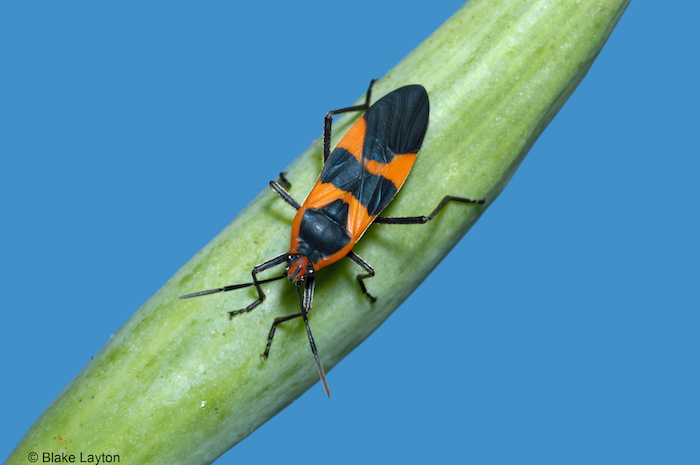Large Milkweed Bug, Vol. 7, No. 11
Related News
April 11, 2013
April 2, 2013
March 14, 2013
February 28, 2013

Large milkweed bugs may look like they are dressed for Halloween, but they are really dressed for defense. In nature this black and orange color combination usually signals danger or bad taste. Milkweed bugs don’t normally bite, but they are distasteful to predators and cause illness in birds or mammals that eat them. Of course, this is also true of Monarch butterflies, which also feed on milkweed and are colored orange and black. Both insects store toxins they consume when feeding on the milkweed plants and use them for self-defense.
It seems most insects that feed on milkweed share this black and orange coloring or have other bright warning colors. This includes the small milkweed bug, which looks much like the large milkweed bug but is, well, smaller. Animals that have protective traits and exhibit common warning colors like this gain a group benefit because predators learn to avoid anything that is orange and black. In the world of biology, this sharing of common color or appearance by different species to gain mutual protection is known as Mullerian mimicry. There are also cases where animals that are harmless exhibit warning colors or markings. Most flower flies mimic bees or wasps but flower flies are unable to sting. This is called Batesian mimicry.
Adult milkweed bugs range from ½ to ¾ inches long. Although they are usually found on various species of milkweed, Asclepias spp., where they may occur in relatively large numbers, wandering adults are sometimes seen on other plants or locations. This is especially common in the spring when overwintered or migrating adults are searching for milkweed plants. This is another thing these bugs have in common with Monarch butterflies, some populations migrate south in the fall to spend the winter and move back north in spring, following developing milkweed. But they don’t go as far south as Monarchs. Bugs from up north often overwinter in Mississippi and other Gulf States. They can handle south Mississippi winters, but not Iowa winters.
Milkweed bugs are sometimes mistaken for assassin bugs, which are predatory bugs that can give a painful bite if mishandled, and one species, the milkweed assassin bug, has very similar markings and color. Milkweed bugs belong to a different family, known as seed bugs (family Lygaeidae), because many members of this family feed on seeds. In fact, milkweed bug nymphs must feed on milkweed seed to develop properly. Milkweed bug nymphs are also orange, or orange with black spots or wing pads. Even the eggs are yellow to orange and easy to spot, but eggs also contain protective toxins.
Because they are relatively easy to rear and handle in laboratory settings, large milkweed bugs have long been used as “model insects” in various types of entomological research, especially basic research on insect physiology.
Control: There is really no need to control milkweed bugs. Occasionally butterfly gardeners observe high populations of large milkweed bugs on milkweed plants growing in their butterfly garden, especially in late summer and fall. Although milkweed bugs can be killed by spraying with bifenthrin, zeta-cypermethrin or similar products, such insecticides will also kill Monarch butterflies and their caterpillars. Fortunately, milkweed bugs feed mainly on the seed pods and even relatively high populations cause little real damage.
Blake Layton, Extension Entomology Specialist, Mississippi State University Extension Service.
The information given here is for educational purposes only. Always read and follow current label directions. Specific commercial products are mentioned as examples only and reference to specific products or trade names is made with the understanding that no discrimination is intended to other products that may also be suitable and appropriately labeled.
Mississippi State University is an equal opportunity institution.
Bug’s Eye View is now on Facebook. Join the Bug's Eye View Facebook group here.